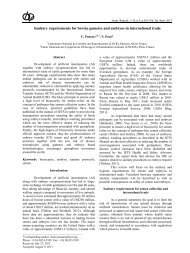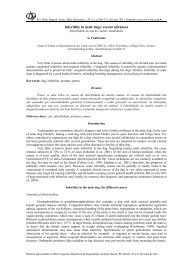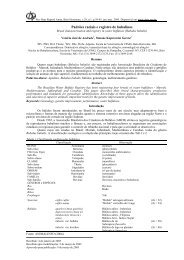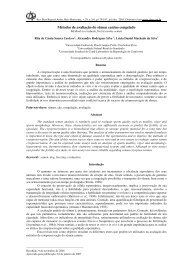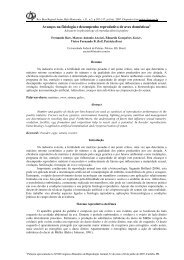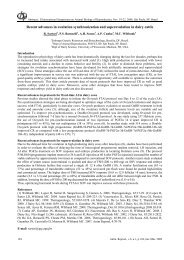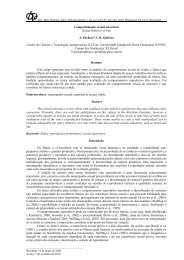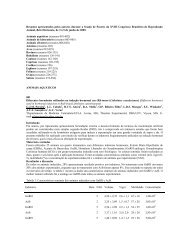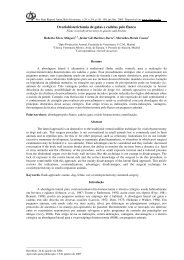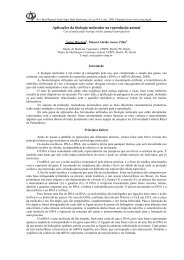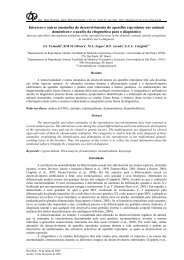Endocrine control of ovarian function in dogs and other carnivores
Endocrine control of ovarian function in dogs and other carnivores
Endocrine control of ovarian function in dogs and other carnivores
You also want an ePaper? Increase the reach of your titles
YUMPU automatically turns print PDFs into web optimized ePapers that Google loves.
Concannon et al. Ovarian <strong>function</strong> <strong>in</strong> <strong>dogs</strong> <strong>and</strong> <strong>other</strong> <strong>carnivores</strong>.<br />
levels <strong>and</strong> then beg<strong>in</strong>n<strong>in</strong>g to plateau or decl<strong>in</strong>e is a <strong>function</strong><br />
<strong>of</strong> the development <strong>of</strong> proestrus follicles to a stage <strong>of</strong><br />
ovulatory competence, <strong>and</strong> likely represents a means to<br />
signal that stage <strong>of</strong> development to the H-P axis. However,<br />
there must also be a component provided by <strong>in</strong>creased<br />
metabolism <strong>of</strong> the estradiol, both by <strong>in</strong>creased liver<br />
microsomes <strong>and</strong> by <strong>in</strong>creas<strong>in</strong>g mass <strong>of</strong> estrogen responsive<br />
tissues <strong>in</strong> the reproductive tract. The liver effectively clears<br />
the majority <strong>of</strong> estradiol from the blood dur<strong>in</strong>g a s<strong>in</strong>gle<br />
pass <strong>of</strong> the circulation <strong>and</strong> any significant amount <strong>of</strong><br />
estrogen-<strong>in</strong>duced <strong>in</strong>crease <strong>in</strong> steroid catabolism would be<br />
Relax<strong>in</strong>, Prolact<strong>in</strong> (ng/ml)<br />
100<br />
10<br />
1<br />
0.1<br />
0.01<br />
expected to impact circulat<strong>in</strong>g concentrations <strong>of</strong> the<br />
hormone. The role <strong>of</strong> <strong>in</strong>creased metabolism <strong>in</strong> <strong>dogs</strong> is also<br />
born out by the fact that <strong>in</strong> prelim<strong>in</strong>ary studies <strong>in</strong><br />
ovariectomized steroid treated bitches, the percent<br />
<strong>in</strong>creases <strong>in</strong> serum estradiol were rout<strong>in</strong>ely far below those<br />
<strong>of</strong> the <strong>in</strong>creas<strong>in</strong>g estradiol dosages be<strong>in</strong>g adm<strong>in</strong>istered.<br />
Likewise, <strong>in</strong>creases <strong>in</strong> peripheral concentrations <strong>of</strong><br />
progesterone may only partially reflected the extent <strong>of</strong><br />
<strong>in</strong>creases <strong>in</strong> actual progesterone secretion, as mentioned<br />
above <strong>in</strong> regards to can<strong>in</strong>e pregnancy <strong>and</strong> <strong>in</strong>creased<br />
peripheral <strong>and</strong>/or hepatic clearance.<br />
-8 0 8 16 24 32 40 48 56 64<br />
Figure 11. Mean concentrations <strong>of</strong> relax<strong>in</strong>, fibr<strong>in</strong>ogen <strong>and</strong> prolact<strong>in</strong> dur<strong>in</strong>g pregnancy <strong>in</strong> beagle bitches, shown on a log<br />
scale so as to clarify the extent <strong>of</strong> co<strong>in</strong>cidence <strong>in</strong> the rise <strong>of</strong> relax<strong>in</strong> <strong>and</strong> the <strong>in</strong>itial pregnancy specific <strong>in</strong>crease <strong>in</strong> prolact<strong>in</strong>.<br />
The simultaneous dramatic rise <strong>in</strong> relax<strong>in</strong> at the time that prolact<strong>in</strong> first appears to be elevated pregnancy-specifically<br />
above preced<strong>in</strong>g mean concentrations supports, along with reports <strong>of</strong> relax<strong>in</strong> mediated <strong>in</strong>creases <strong>in</strong> prolact<strong>in</strong> secretion <strong>in</strong><br />
monkeys <strong>and</strong> pigs, a signal<strong>in</strong>g role for relax<strong>in</strong> <strong>in</strong> pregnancy specific elevated prolact<strong>in</strong> secretion <strong>in</strong> <strong>dogs</strong>.<br />
Anestrus <strong>and</strong> monoestrus cyclicity<br />
In obligate-anestrus species like the dog, as<br />
well as seasonally monoestrus species, a comb<strong>in</strong>ation <strong>of</strong><br />
factors that normally <strong>function</strong> to suppress the H-P axis<br />
<strong>and</strong> LH pulsatility dur<strong>in</strong>g anestrus become dim<strong>in</strong>ished<br />
or less effective shortly before the spontaneous onset <strong>of</strong><br />
proestrus. There is an absolute requirement for cessation<br />
<strong>of</strong> luteal <strong>function</strong> <strong>and</strong>/or decl<strong>in</strong>es <strong>in</strong> peripheral<br />
progesterone to concentrations no longer suppressive to<br />
the H-P-axis. Whether <strong>in</strong>tra<strong>ovarian</strong> concentration <strong>of</strong><br />
progesterone is important <strong>in</strong> regulat<strong>in</strong>g <strong>ovarian</strong> follicle<br />
responsiveness has not been studied <strong>in</strong> <strong>dogs</strong>. Also<br />
potentially <strong>in</strong>volved are alterations <strong>in</strong> hypothalamic<br />
Days from preovulatory LH surge<br />
opioidergic, serotonergic <strong>and</strong>/or dopam<strong>in</strong>ergic activity<br />
that might <strong>in</strong>crease GnRH pulsatility either directly or<br />
as a result <strong>of</strong> effects on prolact<strong>in</strong> secretion. Increased<br />
GnRH pulsatility might be elicited directly or <strong>in</strong>directly<br />
or modulated by changes <strong>in</strong> peripheral <strong>and</strong> central<br />
hormonal milieu that occurs as part <strong>of</strong> any endogenous<br />
circannual cycle that <strong>in</strong> <strong>dogs</strong> is not typically<br />
photoperiod-entra<strong>in</strong>ed. The processes <strong>in</strong>volved may also<br />
be modified by exposure to environmental cues<br />
<strong>in</strong>clud<strong>in</strong>g photoperiod, especially <strong>in</strong> seasonal breeders,<br />
as well as a bitch-bitch pheromonal stimulation <strong>in</strong><br />
domestic <strong>dogs</strong>. In addition, as anestrus progresses <strong>in</strong><br />
bitches, gonadotrope sensitivity to GnRH <strong>in</strong>creases, as<br />
does the mean concentration <strong>of</strong> FSH (Okkens <strong>and</strong><br />
Anim. Reprod., v.6, n.1, p.172-193, Jan./Mar. 2009 185



